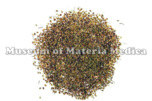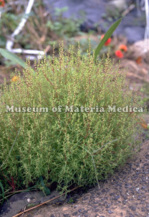Artemisia Capillaris Flower

|
Market name:茵陳蒿 Photo location:Museum of Materia Medica, Inst. of Nat. Med. TMPW No.:11429 |

|
Plant name:Artemisia capillaris Photo location:Toyama Pref., Japan Photo date:1993 Photographer:S. Yamaji |
| Synonym | |
| Latin name | Artemisiae Capillaris Flos |
| Botanical source: Family name | Asteraceae (=Compositae) |
| Botanical source: Plant name | Artemisia capillaris Thunberg (IPNI:179314-1) |
| Part used | Flower head |
| Empirical criteria for quality selection | Good MIAN-YINCHEN-HAO (Artemisia Capillaris Flower collected in spring) has thin leaves like cotton yarns. Good one produced in Japan consists of spikes only. It has a characteristic odor and bitterness, which are the stronger the better. (TN) |
| Constituents | Monoterpenoids: [A. capillaris: β-Pinen Chromones: [A. capillaris]: Capillarisin Coumarins: [A. capillaris (seedlings)]: Scoparone (= Esculetin-6,7-dimethylether), Scopoletin Isocoumarins: [A. capillaris]: Capillarin Other aromatic derivatives: [A. capillaris (spikes)]: Capillone, Norcapillene, Capilline, Capillene |
| Pharmacological effects | Increase in bile secretion (decoction, ethanol extract, esculetin, capillin, capillarisin). |
| Indications | As an antiinflammatory, normalizing the gallbladder function, antifebrile and diuretic, it is applied to treat jaundice, hepatitis and cholecystitis. |
| Diseases | Jaundice, Oliguria, Full stomach, Fever, Restlessness, Chest pain, Pain of lateral sides of trunk, Feeling of bitter in the mouth, Muddy and watery stool, Edema, Chill, Lack of energy, Urticaria, Itching |
| Formulas | inchinkoto , inchingoreisan , kamigedokuto , kanroin |
| Meridian tropism | Spleen, Stomach, Liver, Gall bladder |
| Property | Neutral, Slightly cold |
| Flavor | Bitter |
| Classification in "Shen-non Ben-cao Jing" | Superior |
| TCM: Classification | Diuretics with removing dampness |
| TCM: Medicinal effects | To remove damp-heat and relieve jaundice. Used for jaundice and oliguria, infectious icteric hepatitis, sores with exudation and itching. |
| Remarks | Listed in the Japanese Pharmacopoeia 18th ed. |
| References | TN: T. Namba & Y. Tsuda ed., Outline of Pharmacognosy, a Textbook, 3rd ed., Nankodo Co., Ltd., Tokyo, 1998. |
DNA sequences of medicinal plants
| Gene Region | |||||||||||||||||||
| Nuclear | Chloroplast | Mitochondria | |||||||||||||||||
| Botanical source: Plant name | 5Ss | 18S | ITS1 | 5.8S | ITS2 | 26S | others | trnH-psbA | matK | trnK | trnK-rps16 | trnT-L | trnL | trnL-F | rbcL | rpoC1 | ndhF | others | |
|
|
|||||||||||||||||||
